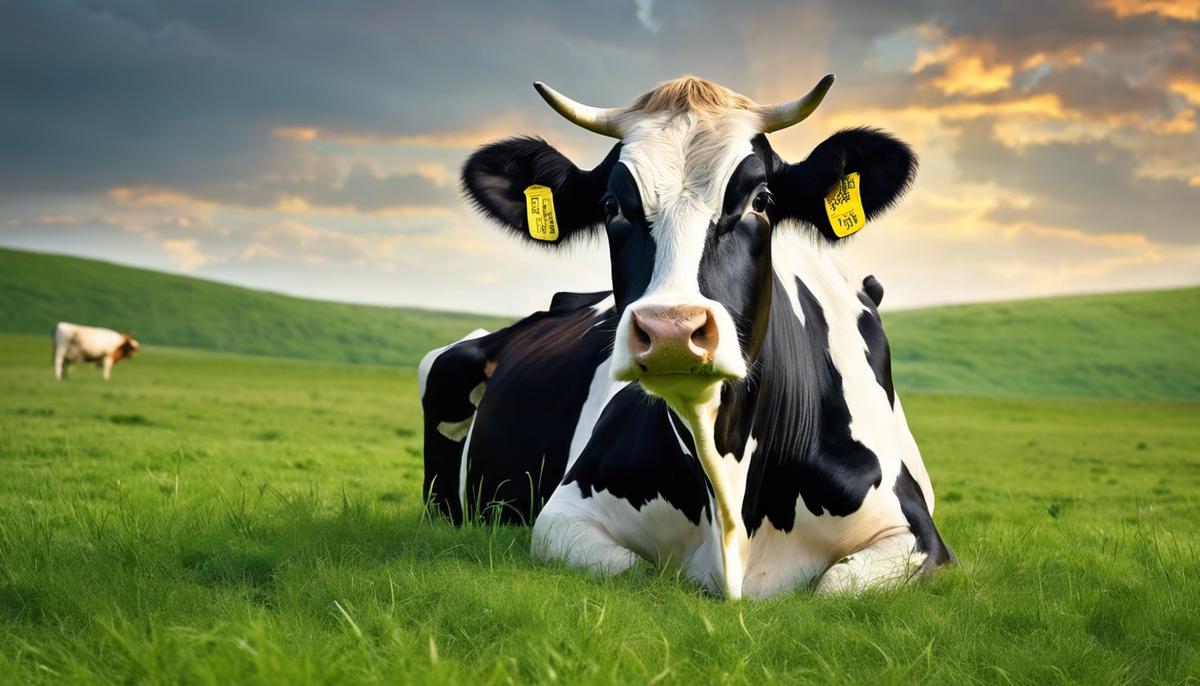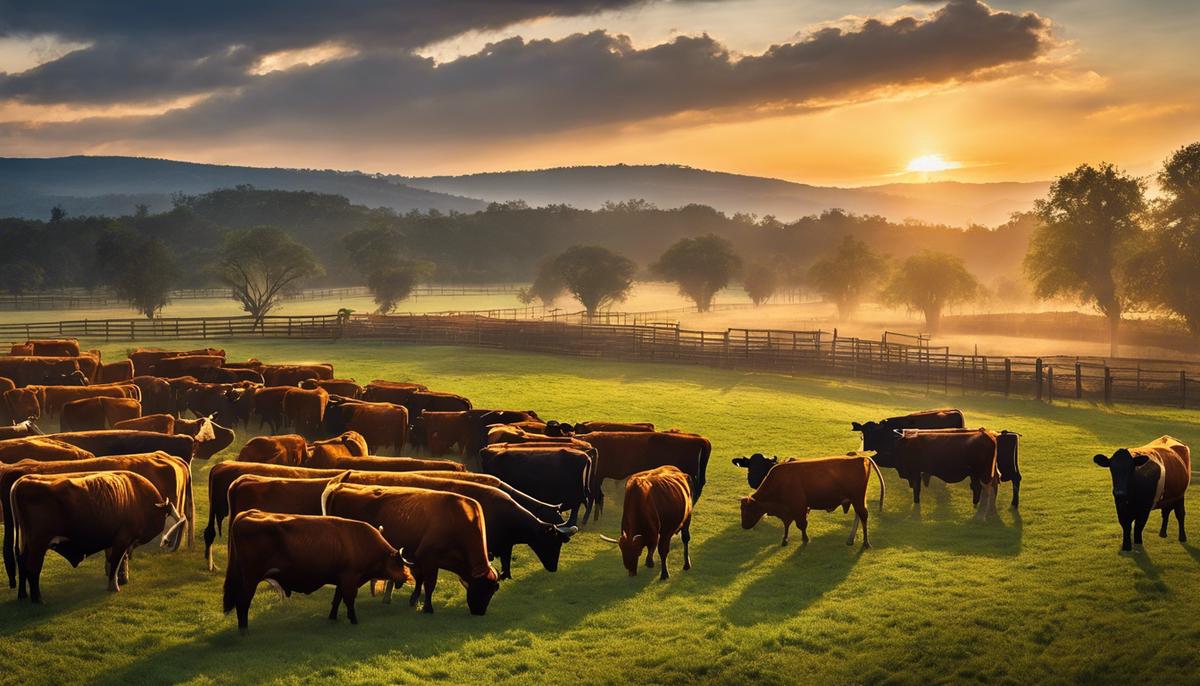

Agridisk
Egypt - Alexandria

Cattle feed mixer & cattle feeder futures
Description: Exploring the meticulous world of cattle feed mixing unveils a fascinating intersection of science and technology, where the utmost care for animal nutrition meets innovative engineering. The quest for perfecting cattle diets through precisely mixed feed is not just about sustaining the animals; it delves deep into the science of cattle nutrition, which scrutinizes the balance of proteins, carbohydrates, fats, vitamins, and minerals necessary for their thriving. As we journey through the evolution of feed mixer technology, we uncover how state-of-the-art machinery designs play a critical role in optimizing farm productivity and advancing the agricultural industry. This essay aims to shed light on the intricate ballet of nutrients within feed mixers, the technological prowess behind them, and the economic currents that drive their use in cattle farming. In the dynamic field of animal science, one of the paramount aspects influencing the health and productivity of cattle is nutrition. Optimized cattle feed mixing represents a critical component in the advancement of bovine dietary management, ensuring that each animal receives balanced and comprehensive nutrition. This practice is instrumental in bolstering the efficiency of feed utilization, promoting health, and enhancing the production of quality beef and dairy products. Optimized feed mixing is predicated on the meticulous calculation and combination of feed ingredients to meet the specific nutritional requirements of bovine herds. These requirements vary according to age, sex, breed, health status, and production goals (e.g., milk yield, growth rate), thereby necessitating precise formulation. The optimal blend, scientifically known as the Total Mixed Ration (TMR), amalgamates all dietary essentials - including forages, grains, protein supplements, minerals, and vitamins - into a homogenous mixture. From a nutritional purview, homogeneity is of the essence. It prevents selective feeding behavior, a common obstacle wherein cattle choose palatable components, possibly leading to nutrient deficiencies or imbalances. A homogeneous mix guarantees that each intake provides cattle with a consistent and comprehensive snapshot of their dietary requirements, thus curbing selective feeding while improving nutrient digestibility and absorption. To achieve optimization in feed mixing, agronomic advancements, such as the implementation of precision feeding technologies, are utilized. Precision technology aids in the precise weighing and dispensing of ingredients, while sophisticated mixing equipment ensures even distribution. This integration of technology within cattle feed preparation enhances nutrient use efficiency, translating to better growth rates, milk production, and overall health of the herd. Furthermore, optimized feed mixing encompasses the incorporation of dietary fiber, pivotal to rumen function and health. An adequate fiber level within the TMR fosters a suitable rumination process and microbial balance within the rumen, which in turn facilitates the breakdown of complex dietary components into volatile fatty acids - vital energy sources for bovine individuals. The application of optimized cattle feed mixing also addresses the reduction of environmental impacts. Efficient utilization of feed not only reduces waste but also mitigates the release of methane - a potent greenhouse gas produced during enteric fermentation in cattle. As such, the methodology plays a role in environmental stewardship, contributing to the sustainability of cattle farming practices. In conclusion, optimized cattle feed mixing embodies an amalgamation of scientific understanding, precision technology, and rigorous formulation strategies aimed at enhancing bovine nutrition. Through this multifaceted approach, stakeholders in the cattle industry can secure improved animal welfare, enhanced production efficiency, and a movement towards more sustainable agricultural practices. As research in the field proliferates, one anticipates continuous refinement of feed mixing methodologies, heralding a future where optimized nutrition remains at the fore of bovine health and productivity. The pursuit of agricultural efficiency has catalyzed the evolution of cattle feed mixing technology, striving towards exemplary standards of homogenization and nutritional precision. Modern cattle feed mixers are manifestations of innovation, marrying the intricate knowledge of bovine nutrition with mechanical engineering and software prowess. Foremost in this realm is the adoption of automated control systems within mixer mechanisms. The intricacy of these systems lies not only in maintaining the proper mix ratios but also in the ability to make real-time adjustments, calibrated to environmental conditions, herd intake patterns, and input variability. The inclusion of on-board microprocessors and networked sensors within load cells and augers enfolds error margins and heightens the fidelity of mix constituents. The emergence of programmable logic controllers (PLC) has further revolutionized feed mixer operations. These devices allow for the precise synchronization of mixing cycle duration, speed, and sequence, thus enabling a homogenous blend devoid of nutritional strata or segregation. The remarkable consistency achieved by PLC-operated mixers contributes significantly to the diminishment of selective feeding behavior previously discussed. A novel frontier in modern mixers is the amalgamation of vertical and horizontal mixing technologies. Vertical mixers, excelling in cutting and mixing forage to attain optimal fiber length, work in synergy with horizontal mixers, which are adept at blending different feed types uniformly. The convergence of these technologies ensures a comprehensive amalgam of textures and nutrients, akin to the multifaceted diets natural to the bovine species. Next-generation mixers have mobilized the use of self-propelled units, equipped with advanced navigation systems, which render the deployment of feed a task of precision. These autonomous units follow pre-determined routes, mitigating manual labor and ensuring consistent delivery of feed across large farming operations. This precision directly correlates to lower operational costs and higher levels of herd uniformity in consumption. The incorporation of telematics and cloud-based data analysis offers a panoramic view of mixer efficiency and feed utilization. By analyzing data trends over time, operators can pinpoint areas for refinement, guiding them towards strategies that align with environmental stewardship and the ethos of sustainable farming. It is noteworthy that with the advent of wireless connectivity, feed mixers have become integral components of the Internet of Things (IoT) in agriculture, earning them a place in the comprehensive farm management systems. In conclusion, the technological advancements defining modern cattle feed mixers showcase a dual commitment to nutritional excellence and operational pragmatism. The ingenious integration of control systems, mixer technologies, autonomous operations, and data analytics amplifies the potential for optimized cattle nutrition, epitomizing a future where the well-being of herds and the health of the planet are intertwined goals, pursued with equal vigor and intellectual determination. Given the aforementioned groundwork established in the optimization of cattle feed mixing, several critical metrics must be considered to further assess the performance and efficacy of these mixers. These metrics serve as quantifiable indicators, guiding progress towards attaining the goal of producing a uniformly mixed ration that meets the stringent nutrition standards required for cattle health and production. Firstly, the coefficient of variation (CV) emerges as a pivotal metric. It is a measure of the mixer's ability to produce a thoroughly mixed TMR. A low CV percentage is indicative of an evenly distributed mix, ensuring consistent nutrient intake by all animals within a cohort. The CV provides insight into the mixer’s precision and repeatability, critical factors in the prevention of nutritional stratification within the feed. Another influential metric is the mixing time, which denotes the duration required to achieve the desired homogeneity of feed constituents. Overmixing can lead to the degradation of certain feed components, whereas under-mixing results in non-uniform distribution of nutrients. Identifying the optimal mixing time is, therefore, central to preserving the integrity of ingredients while ensuring their even dispersion. Particle size reduction rate is a further consideration, as it assesses the machine's effectiveness in reducing the size of feed particles to an appropriate level for optimal digestion and absorption of nutrients by cattle. This factor is also closely monitored to maintain the physical characteristics necessary for rumen health. Additionally, mixer wear and maintenance frequency offer insights into the durability and cost-effectiveness of the unit over time. These metrics underscore the longevity of the mixer elements and the intervals between servicing, which are vital for continuous operation and economic viability. Energy consumption per mixing cycle represents yet another metric with dual implications for both economic and environmental aspects. It reflects the efficiency of the mixer in terms of power usage, which directly impacts operating costs and the ecological footprint of the feeding operation. Batch-to-batch consistency is measured to ensure that each batch of feed delivered to the cattle is uniform in terms of nutrient content and quality. This metric speaks to the reliability of the mixer and the precision of its controlling mechanisms. Lastly, the metric of mixer throughput evaluates the amount of feed that can be processed within a given time frame, highlighting the capacity of the mixer to meet the demands of larger-scale operations. In conclusion, assessing the performance and efficacy of cattle feed mixers involves a comprehensive evaluation of various key metrics. These include the coefficient of variation, mixing time, particle size reduction rate, mixer wear, energy consumption, batch-to-batch consistency, and throughput. Monitoring these metrics ensures the production of a high-quality, homogeneous TMR, conducive to optimal cattle health and productivity, while adhering to the principles of sustainability and resource management integral to modern cattle rearing practices. The economic impact of feed mixers on cattle farming can be quantified by examining aspects such as feed conversion ratios (FCR), labor costs, and operational expenditures associated with feeding practices. These factors play a pivotal role in the fiscal outcomes of cattle rearing operations. Feed conversion ratio is a critical efficiency indicator, representing the amount of feed required to produce a unit of animal body weight. Improvements in mixing technology directly correlate with enhanced FCRs, as cattle are provided with a diet that is thoroughly blended, ensuring each bite contains a balanced mixture of required nutrients. This maximization of nutrient uptake reduces the quantity of feed necessary for weight gain, yielding economic benefits through diminished feed costs. Labor costs are substantially influenced by the deployment of advanced feed mixers. The automation and precision afforded by these systems curtail the need for manual labor in the mixing process. The concomitant labor savings can be reallocated to other essential tasks within the operation, enhancing overall productivity and profitability. Operational expenses are further impacted by factors such as mixing time and energy consumption. Ideally, a feed mixer should operate efficiently, reducing the amount of time needed to create a consistent blend. As mixers adopt more advanced technologies, they can achieve optimal results swiftly, diminishing the energy costs involved in producing TMRs. The wear and maintenance frequency of mixers affect their cost-effectiveness. Durable, low-maintenance models decrease downtime and repair costs, thereby augmenting economic outcomes. Manufacturers continue to innovate with materials and designs that extend the lifespan of these essential machines. Batch-to-batch consistency is essential for maintaining cattle health and meeting production targets. Inconsistent feed can lead to variability in cattle growth rates and health. Modern feed mixers, outfitted with sophisticated monitoring and control systems, ensure uniformity in feed production, enhancing the reliability and economic stability of cattle farming ventures. In conclusion, mixer throughput, a term describing the volume of mixed feed produced over time, must be optimized to meet the demands of the herd without creating excess. An aptly chosen feed mixer, tailored to the size and needs of the operation, can prevent the financial drain of overproduction and material waste. In sum, the economic footprint of feed mixers on cattle farming is substantial. Their role in ensuring efficient feed usage, reducing labor and operational costs, and guaranteeing consistent, high-quality nutrition for livestock is indispensable. These machines are not mere tools but pivotal investments in the economic vitality of cattle farming enterprises. The intricate web of considerations in selecting and operating cattle feed mixers underscores their pivotal role in the modern agricultural paradigm. As we've explored, the sophistication of mixer technology is not purely a triumph of engineering, but more so a testament to the agricultural community's dedication to animal welfare and efficiency. By ensuring homogenous mixes that support the health and growth of cattle, enhancing farm productivity through precision and smart design, and committing to the economic vitality of farming operations, these machines serve as unsung heroes in the pasturelands. Ultimately, the effective use of feed mixers stands as a hallmark of successful cattle farming, weaving together the science of nutrition and economic pragmatism with the thread of technological innovation. Understanding the dynamics of the agricultural industry is vital, particularly the complexities tied to the livestock market. One facet worth exploring is cattle feeder futures—a financial derivative linked to the price of feeder cattle. This ready-for-fattening livestock holds great significance not just in the farming sector, but also in the financial world. Producers and various industry stakeholders find it a helpful avenue in hedging risks and securing stable prices. Our journey through this fascinating topic will guide us through the intricate market dynamics, the process of trading, and finally, the potential risks and their effective mitigation. Cattle feeder futures - a phrase that, at first glance, may seem out of place in the business world. After all, what connection do livestock and farming have to high-paced commerce and finance sectors? Surprisingly enough, the connection is more profound than one might imagine. Essentially, cattle feeder futures represent a type of investment strategy that speculates on the future price of livestock. Specifically, these are contracts bought and sold, predicting the price of physically ready marketable cattle in the future, hence the term "futures". But how does this fit into the grand scheme of the business world? For starters, the agricultural sector functions synergistically with numerous other industries, making it a cornerstone of the global economy. Consider this: when cattle prices fluctuate, not only do agribusinesses feel the impact, but so does the restaurant sector, the retail industry, and even the world of fashion, among others. A surge in cattle prices might mean costlier burgers at your favorite restaurant or more expensive leather jackets at the mall. Consequently, understanding cattle feeder futures makes market predictions significantly more precise. Moreover, these futures present yet another innovative investment opportunity. Just as in any other futures market like gold, oil or cotton, savvy traders and businesses can leverage cattle feeder futures to hedge against unpredictable market swings. This encourages more stability within the agricultural industry and, by extension, the interconnected business sectors. The significance of these livestock contracts further demonstrates the sheer interconnectedness of the modern business world. This isn't a game of isolated chess pieces, where sectors independently move and function. Instead, think of it as a dynamic web, where a single tremor in one sector could potentially ripple across the entire spectrum. Consider this: a sudden epidemic impacts the cattle supply, which hikes up the costs of cattle feeder futures. This, in turn, influences the entire agribusiness supply chain. The cattle-dependent industries, like restaurants and clothing manufacturers, may face increased production costs. Ultimately, this could even cause a domino effect, sending shockwaves through the global economy. In essence, one cannot underestimate the importance of a seemingly specialized and isolated market such as cattle feeder futures. Like every component within the business world, they fulfill a role that, though it may be unapparent at first glance, proves vital in maintaining balance in the grand scheme of things. Maintaining a comprehensive understanding of these dynamics not only aids in making more informed business decisions but also promotes a broader and more robust view of the business world. Remember, knowledge and innovation, no matter how specific, is power in the global economy. The characterization of the cattle feeder futures market is analogous to a fast-paced, complex labyrinth. Timing, knowledge, and predictive skills are essential to navigate and win in this game. To thoroughly comprehend and shield oneself from potential pitfalls, one ought to grasp the significant price influencers within this intricate market. A plethora of elements coalesces to affect the cattle futures price. Weather, feed prices, and international trade constitute the prime movers, each wielding immense sway over market trends. Weather significantly shapes the cattle industry. Anomalous weather conditions, such as droughts or excessive rain, can drastically stymie cattle growth, delaying them from reaching the market weight. This delay can constrict the supply, thereby inflating the prices in the futures market. On the flip side, favorable weather accelerates cattle growth and consequently uplifts the supply, antithetically affecting the market prices. The cost of feeds is a direct contributor to beef production costs, which ultimately shapes the cattle futures prices. Dramatic fluctuations in grain prices can significantly vex the cost-effectiveness of cattle-raising. When grain prices skyrocket, ranchers often seek to swiftly offload cattle into the market, thus swamping supply and depressing prices downwards. International trade is more relevant now than ever in this market. Sanctions, trade agreements, tariffs, and global market trends reshape the international beef-trade landscape. A booming foreign market, fortified by diminishing trade barriers, can raise cattle prices by ramping up demand. Conversely, erected trade barriers or recessions can curb the demand, triggering a tumble in prices. Crucially, market speculators also play a pivotal role in this labyrinth. Their bets on future prices may escalate market volatility. However, those with keen market acuity can utilize this volatility to their advantage, securing favorable deals on future contracts. In essence, the valuable insights gleaned from observing these influencers can fortify business strategy, inspiring innovation to streamline processes and cut costs. The astute understanding of various market trends aids in predicting and remaining prepared for potential market fluctuations. This essentially keeps businesses on their toes, ready to adapt, innovate, and ultimately edge out the competition in this fecund, global economy. Successful navigation through the labyrinth of cattle feeder futures market is dependent not only on understanding these factors but also on the nimbleness to swiftly respond to market signals. In closing, the cattle feeder futures market is not merely about cattle - it's a test of your predictive acumen and business savvy. It’s about recognizing connections, decoding trends, and turning knowledge into business prowess that aligns with tomorrow's market today. Thus, it serves as a codex to the successful entrepreneur’s playbook: making informed and innovative business decisions amid a continuously evolving global economy. Knowledge, they say, is power; in this case, it’s both power and profit. Firstly, in a market as specific as cattle feeder futures trading, a thorough understanding of the cattle life cycle and breeding season is essential. This may not seem as natural a knowledge area for savvy entrepreneurs, but in the world of cattle futures, this information plays a phenomenal role in predicting cattle supply, and consequently future prices. A beef animal's commercial life is quite predictable, starting from the spring calving season, the summer grazing feedlot period, and ending with market readiness towards fall or winter. Thus, an awareness of these seasonal cattle life stages allows one to anticipate market supply and be ready for potential price shifts. Secondly, technology has a considerable role in this business field. The use of data analysis tools is instrumental in tracking market trends and potential shifts, giving traders an upper hand in making informed decisions. Data-centric tools help decipher complex datasets representing market trends, supply-demand balances, and price action. They also aid in understanding variables like weather patterns, disease outbreaks, and feed prices that have historical implications on futures prices. Next, always stay informed of government policies and regulatory changes both domestically and globally. Even the slightest amendment in agricultural support systems, trade tax tariffs, or environmental regulations can cause wave effects in the cattle feeder futures market. A trade embargo imposed by a major beef importing nation, for instance, could disrupt futures prices significantly. Lastly, it's all about relationships in the business world, and the cattle futures market is no different. Cultivate professional relationships with industry insiders such as farmers, feedlot operators, and meatpackers. The first-hand, potentially unpublicized, insights into operations such as feeding programs, herd health, and marketing plans provide a strategic advantage that no amount of raw data could offer. In a nutshell, succeeding in the cattle feeder futures market is about adapting the mantra of being proactive, not reactive. It involves painstakingly learning about the beef industry while leveraging technological advancements, remaining keenly alert to policy changes and maintaining close relationships with industry insiders. This expanse of activity needs an entrepreneurial spirit that thrives on challenges - a spirit, that in the rush of city skyscrapers, still feels the thrill in the bellowing of cattle and the rising sun over the feedlots. Indeed, cattle feeder futures trading is a distinctive intersection of agricultural life and financial acumen, requiring not just knowledge and innovation, but a drive that engages with the world in its entirety. In the world of cattle feeder futures trading, it's imperative to take into consideration the implicit risks that come with partaking in such a market area. Despite the comprehensive understanding of how cattle feeder futures operate and their evolving impact across numerous industries, there exist certain uncertainties that could express themselves as potential risks. Part of being a successful entrepreneur in this space is having a clear grasp of these potential hazards. Disease outbreaks, for instance, can significantly impact a cattle producer's yield and, as a result, cause fluctuations in the futures market. Mad Cow disease, Foot and Mouth, and other similar cattle illnesses, have, in the past, profoundly disrupted supply chains and caused spikes in the cattle futures market. Savvy investors need to closely monitor for signs of these outbreaks and be ready to shift their strategies when required. Another key variable to monitor is government regulations. These can impose restrictions on beef tariffs, subsidies, or mandatory health checks, which can subsequently affect the price of feeders. As such, having a finger on the pulse of government policy and regulation changes ensures that entrepreneurs aren't caught off-guard by unexpected shifts in the landscape. Proper risk management strategies are vital because they guard against potential losses that could result from these unforeseen occurrences. Diversification is one such strategy. By investing in a broad array of assets, investors can minimize the potential impact of a single adverse fallout. This doesn't mean that it's enough to spread investments across different commodities. Diversification involves researching and understanding various commodity futures and how they interact. Another critical business strategy is to use option contracts to hedge risk. Options grant the right, but not the obligation, to buy or sell a cattle feeder future at a specific price before a definite date. This allows investors to safeguard their portfolios against volatile market movements, thus giving them an additional layer of protection against the unpredictable nature of the commodities market. Perhaps, one of the most effective ways of mitigating risk is through continuous education and networking. Entrepreneurship is a lifelong learning experience, and the business world doesn't stand still. Staying abreast of current events, breakthrough technologies, and innovations in trading can significantly improve investment strategies. Successful entrepreneurs leverage industry relationships to gain valuable insights, share trading strategies, and foster a sense of camaraderie in the unpredictable world of cattle feeder futures. In conclusion, trading in cattle feeder futures comes with its share of potential risks – from disease outbreaks to regulatory changes, but it's not without strategies to navigate these hazards. As an entrepreneur, being proactive, staying informed, cultivating relationships, and implementing effective risk management strategies not only prepares one for the challenges that lie ahead but also sets the stage for a thriving business within this trading space. Because, after all, it's not about avoiding risks, it's about understanding and managing them. Exploring the intricacies of cattle feeder futures reveals a vibrant intersection of agriculture and finance. This sector plays a crucial role in price prediction, facilitating hedging, and protecting the interests of both producers and investors. Understanding the market dynamics, mastering the trading process, and appreciating the risk mitigation strategies are fundamental to success in this niche. As we continue to scrutinize the various factors influencing this market—from seasonal patterns to grain prices and weather conditions—we equip ourselves with deeper insights into this captivating world, enabling us to navigate with more certainty and confidence.Cattle feed mixer & cattle feeder futures
Cattle feed mixer
The Science of Cattle Nutrition
Understanding the Importance of Optimized Cattle Feed Mixing in Bovine Nutrition

Feed Mixer Technology and Design | Cattle feed mixer
Technological Prowess in Modulating the Mastication Matrix: Modern Cattle Feed Mixers

Assessment of Feed Mixer Performance

The Economics of Feed Mixing in Cattle Farming

Cattle feeder futures
The Concept of Cattle Feeder Futures
Understanding Cattle Feeder Futures: A Critical Link in the Business World

Market Dynamics of Cattle Feeder Futures
"Influencing the Cattle Feeder Futures: Navigating the Market Labyrinth"

Trading Cattle Feeder Futures
Risks and Mitigation in Cattle Feeder Futures
